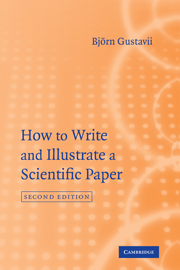Book contents
- Frontmatter
- Contents
- Preface
- Acknowledgments
- 1 Basic rules of writing
- 2 Comments on scientific language
- 3 Drafting the manuscript
- 4 Choosing a journal
- 5 Preparing a graph
- 6 Drawings
- 7 Figure legends
- 8 How to design tables
- 9 Title
- 10 Authors
- 11 Abstract
- 12 Introduction
- 13 Methods
- 14 Results
- 15 Discussion
- 16 Acknowledgments
- 17 References
- 18 Ph.D. and other doctoral theses
- 19 Letters and case reports
- 20 Numbers
- 21 Abbreviations
- 22 How to present statistical results
- 23 Typing
- 24 Dealing with editors and referees
- 25 Correcting proofs
- 26 Authors‘ responsibilities
- Literature needed on your desk
- Further reading
- Literature cited
- Index
19 - Letters and case reports
Published online by Cambridge University Press: 05 June 2012
- Frontmatter
- Contents
- Preface
- Acknowledgments
- 1 Basic rules of writing
- 2 Comments on scientific language
- 3 Drafting the manuscript
- 4 Choosing a journal
- 5 Preparing a graph
- 6 Drawings
- 7 Figure legends
- 8 How to design tables
- 9 Title
- 10 Authors
- 11 Abstract
- 12 Introduction
- 13 Methods
- 14 Results
- 15 Discussion
- 16 Acknowledgments
- 17 References
- 18 Ph.D. and other doctoral theses
- 19 Letters and case reports
- 20 Numbers
- 21 Abbreviations
- 22 How to present statistical results
- 23 Typing
- 24 Dealing with editors and referees
- 25 Correcting proofs
- 26 Authors‘ responsibilities
- Literature needed on your desk
- Further reading
- Literature cited
- Index
Summary
The thalidomide letter
The X-ray image of a woman in late pregnancy showed a fetus without arms. “Once in a lifetime, we are supposed to see something like this, but I have seen it twice in a couple of months,” said one radiologist. Rumors of an increase in similar defects were frequent – the cause unknown.
About two months later, in December 1961, a letter appeared in The Lancet stating that women receiving thalidomide in early pregnancy for morning sickness frequently had babies with missing or deformed limbs (McBride 1961). The letter, comprising only 15 lines, ended with the following question:
Have any of your readers seen similar abnormalities in babies delivered of women who have taken this drug during pregnancy?
The response was overwhelming. Eventually more than 10 000 babies in almost 50 countries were born with such defects (Thalidomide UK 2006). After the publication of the letter, the drug was immediately withdrawn worldwide. This letter counts as the first milestone for The Lancet (www.thelancet.com, accessed 9 December 2006) since its announcement of the value of penicillin in 1940.
Format and size of a letter
Just as in the thalidomide letter, you should be brief and to the point. The format of a letter is almost always the same: a title; a salutation, for example, “To the Editor”; the letter itself without subheadings; and a list of references. You may include one figure or one table, though such additions will be published only if they add substantially to the letter.
- Type
- Chapter
- Information
- How to Write and Illustrate a Scientific Paper , pp. 101 - 104Publisher: Cambridge University PressPrint publication year: 2008



